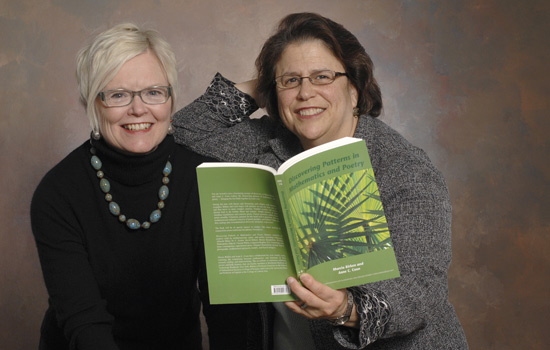Dynamic duo searches for math, poetry parallels
A. Sue Weisler | photographer
Anne Coon, left, and Marcia Birken collaborated on their new book Patterns in Mathematics and Poetry.
What do Fibonacci Numbers, the Golden Ratio and poetry have in common? Their patterns and the analogies they inspire help us to express fundamental concepts, make new discoveries and comprehend the mysterious, say Marcia Birken and Anne Coon.
The mathematician and the poet have been on a treasure hunt of sorts, searching mathematics and poetry for points of similarity and areas of overlap for more than 25 years. Along the way, they found significant connections in their respective fields through analogies and patterns, and they have gained a mutual appreciation for each other’s discipline.
Written for a general audience, Patterns in Mathematics and Poetry is the result of their unlikely partnership and lengthy collaboration. The book grew from the course “Analogy, Mathematics and Poetry” (later “Patterns in Mathematics and Poetry”) that Birken and Coon developed and taught, as well as from their countless papers, conferences and workshops on related topics.
“The book is meant for scientists who love poetry and poets who love science and math,” says Coon, senior associate dean and professor of English in the College of Liberal Arts and the author of several books of poetry.
“People who seek patterns are always looking for new ones,” adds Birken, professor emeritus in the School of Mathematical Sciences in the College of Science and an award-winning nature photographer. “They want to see things in new ways.” Birken and Coon show their readers how to cast an interdisciplinary eye toward examining patterns of counting, form and fractals, as well as patterns for the mind—proof, paradox and infinity.
The book is illustrated with mathematical images and Birken’s photographs from her travels around the world that help explain math to non-experts. Poets whose work is featured in the book include e.e. cummings, Mary Oliver, Harvard mathematician Barry Mazur and RIT graduate Chris Wiltz.
The authors appreciate the support they received from their colleges and from the provost’s office to make the interdisciplinary connections that intrigued them and which eventually led to their book. The unusual collaboration Birken and Coon fostered during their careers at RIT is now a current trend in academia.
“At RIT right now, there’s a real interest in interdisciplinary connections in general but also in trying to understand what different disciplines share and where they are not the same,” Coon says. She adds: “I think many people with interests in the sciences and the humanities and the arts were intrigued that the two of us had not only done this work but had committed 25 years to watching it unfold. We wrote an essay a few years ago about long-term collaborations and what that’s meant, from negotiating how to write together, to learning to appreciate one another’s disciplines in a profound way.”







